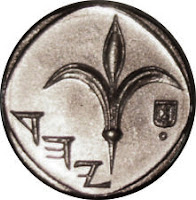How "Sar" Became "Sag" - Explaining Tehillim 14 & 53 Variants with Paleo Hebrew
 One of my beloved amateur hobbies of late is an interest in ancient Hebrew scripts. So I was excited when I found something on the topic to post about.
One of my beloved amateur hobbies of late is an interest in ancient Hebrew scripts. So I was excited when I found something on the topic to post about.From around 1000 BCE to the Babylonian exile, the script in primary use by Israelites/Jews is what we today call "Paleo Hebrew" (or "ktav ivri" as it's referred to in the Talmud). If you live in Israel, you're walking around with examples of it in your pocket right now. On the back of the 1-shekel coin are the letters Yud Hei Dalet, meaning "Yehud," which was the name of the Jewish province in Judah when it was reestablished after Cyrus the Great's decree. The 10-shekel coin also bears a Paleo Hebrew inscription.
I may write more about script development another time, but right now I want to use Paleo Hebrew to offer a possible explanation for a textual variation between two chapters of Tehillim (Psalms), numbers 14 and 53. The two chapters are nearly identical, aside from a few word changes. The below chart (which I found here) highlights the differences.
Some of the variations can be accounted for by editorial preferences, e.g. the choice of which name of God to use. Some are textual additions, like those in 53:6. (That assumes Psalm 53 came later; alternatively, we can say 14:5-6 is a later, condensed version.) Others are minor grammatical changes, like the word kulo instead of hakol, both of which mean "all." These kinds of variations are attested in other duplicate texts throughout Tanakh.
There is one variation however that caught my eye, which is sar (14:3) versus sag (53:4). Sar (סר) means "turn aside" or "depart." Sag (סג) means "turn away" or "move back." Two very similar words, implying departure, the first possibly connoting more of a sideways movement, a change in direction, and the second more of a backwards movement, a retreat of sorts.
The question is how or why does sar change to sag?
One possibility is that it's an intentional change. That could mean a deliberate editorial revision, using two different words to communicate subtly different meanings. It could also be more of an inexact "retelling" of the psalm. Meaning, the author or scribe didn't feel the need to repeat it word for word. It was simply written to impart roughly the same idea, and for that purpose sag works as well as sar.
A second possibility is that the intent was in fact to duplicate the verse, but the result was slightly off.
Inadvertent changes can result from auditory, memory-related or visual factors. If the scribe works by taking dictation, the person may call out "sar" but the scribe hears it as "sag." If the scribe transcribes by rote memory, it could be that they've memorized it (perhaps even heard it recited by others) as sag. The two words after all do sound similar and mean almost the same thing, so it's easy to see how such an inadvertent substitution could occur. Then there's the visual factor, which gets to what I wanted to offer in this post.
In modern Hebrew, sar and sag might look vaguely similar, by virtue of being two-letter words beginning with a samekh, but they're still fairly easy to tell apart. You wouldn't tend to mistake resh and gimel for one another. Likewise, in early modern Hebrew, the "Jewish script" of the 3rd to 2nd centuries BCE, the two letters have significantly different forms, not easily misread one as the other. However, when you go back to Paleo Hebrew script, resh and gimel are almost identical apart from an additional connecting bar that distinguishes the resh. See the chart below.
Let's say that this particular scribe is working by reading directly from a source text. If the letter resh in the word sar has a less pronounced connecting bar (i.e. it's drawn close to the upper bar, which in fact occurs in some instances of the Paleo resh), or even if it doesn't but we're talking about a mere half-second glance at the source text, that resh could easily be mistaken for a gimel. The scribe then copies it that way, and sar henceforth becomes sag. It doesn't get subsequently corrected, since sag is a word in its own right, and even has a similar meaning.
If this is how the variant was created, it would indicate that the change from sar to sag (or the other way around, depending on which psalm is older) goes back to pre-exilic times, when writing was done in Paleo Hebrew.
To be clear, I'm not arguing that this is necessarily how sar became sag, or vice-versa. As I mentioned, there are a number of potential explanations for how the two versions came to be, including it being an intentional change. I only put this forward as a possibility to add to the mix, one which might normally escape our modern eyes due to our lack of familiarity with ancient Hebrew scripts. (And like I say, I do have a soft spot for Paleo Hebrew.)
This last point highlights a larger issue in terms of knowledge and methodology. If this particular Paleo Hebrew hypothesis doesn't hold up in the face of scholarly scrutiny, that's okay. The point is not to become so invested in our ideas that we feel we have to "advocate" for them. Rather, put the idea out there, see if the evidence supports it, and evaluate how it stacks up against other explanations in terms of plausibility. And know that at the end of the day, the best we may be able to say on a particular subject or question is: "We don't know; X, Y and Z are all possibilities." And that too is a great answer.





Comments
Post a Comment
Not sure how to leave a comment? By "Comment as", either choose your Google ID, OR select "Name/URL". Type your name and leave URL blank (if you don't have a web address). Then hit "Publish", type in the letters/number shown, and again "Publish". I don't mind anonymous comments, but please use a pseudonym.